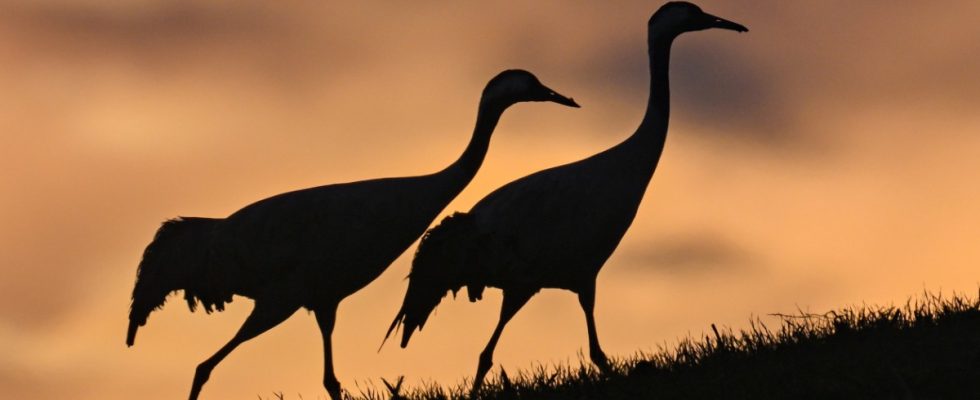A robin recently sang in front of Angelika Nelson’s window. It was beautiful, but somehow strange. After all, it is mid-November. “The bird perhaps thought it was spring,” says the biologist from the State Association for Bird and Nature Conservation (LBV). The day length is appropriate; it is similar in autumn to spring. Added to this are the unusually high temperatures this autumn: October was the warmest since weather records began, and November also saw record-breaking high temperatures.
Animals and plants react to this, it cannot be overlooked. Hedgehogs, who are usually already in hibernation at this time, are still running around in the gardens, bats are also still out and about and many migratory birds, such as starlings, have still not left for their winter quarters. According to the umbrella organization of German avifaunists, the migration of cranes, most of which overwinter in France and Spain, will also be delayed this year. Tens of thousands of these birds are currently resting in northern Germany.
Chiffchaffs and blackcaps have recently started overwintering in Germany
What do the high autumn temperatures caused by climate change mean for nature? Do they harm? Or does it perhaps even help animals and plants when it is still warm in autumn? Hedgehogs, for example, have longer time to eat a sufficiently thick layer of fat. And more and more migratory birds seem to be giving up on migrating south altogether: “In recent years we have been repeatedly reported sightings of chiffchaffs and blackcaps in the middle of winter,” says Nelson. “Just a few years ago this would have been a sensation.” Until recently, both species migrated south to overwinter. The fact that they are here in January means that these animals no longer fly away, but have decided to spend the winter in Germany due to the comparatively mild temperatures, says Nelson. This saved them bird migration, which is always associated with many dangers.
Scientifically, the effects of rising autumn temperatures on nature are surprisingly poorly researched. “Autumn, a neglected season in climate change research,” is the title of a review articlewhich appeared some time ago in the science journal Trends in Ecology & Evolution has been published on the subject.
According to the study authors, it varies greatly depending on the species whether a warm autumn is more harmful or beneficial. In principle, however, it is becoming apparent that flexible species that can adapt relatively quickly to changing environmental conditions tend to benefit, while inflexible species tend to be weakened.
When it comes to migratory birds, for example, many short-distance migrants are more flexible and can decide when and whether to fly at all depending on the situation. “They can still react even if they have decided to stay here, but then it unexpectedly turns into a harsh winter,” says Nelson. In long-distance migrants, on the other hand, migratory behavior is genetically determined in their genome. The cuckoo, for example, winters in Africa south of the equator. The birds leave Germany at the beginning of August and return in the second half of April.
This used to be exactly the right time to feed a cuckoo’s egg to the black redstart. But the black redstart is a short-distance migrant that has changed its migratory behavior due to climate change, often returning to Germany earlier and also starting to breed earlier. The cuckoo then comes literally too late. “The young ones are sometimes already sitting in the nests of their host birds,” says Nelson.
Biologists assume that climate change and the associated higher temperatures in autumn – and also in spring – will result in many such “mismatches”, most of which are not yet known. “Asynchrony can arise when interacting species respond differently to climate change,” write the authors of the review article in Trends in Ecology & Evolution. As a result, the dynamics of entire ecosystems could change.
The warm autumn helps some insects to reproduce
For example, many migratory birds eat the fruits of certain plant species while flying to their winter quarters. In return, they transport the seeds and help the plant spread. Because of the warm autumn temperatures, the birds are now leaving later, and the fruits are ripening earlier: fruit and birds no longer meet. The researchers write that the animals would therefore have to switch to the fruits of other plants. These are often invasive plants that “often produce large quantities of fruits with low nutritional value late in the year.” As a result, the birds have less energy for their migration south and the invasive plants are spread instead of the native ones.
In other areas, the rising temperatures in autumn could also have positive effects. There are indications that some insects can then form additional generations, i.e. reproduce more rapidly.
Scientists cannot currently answer whether the rising temperatures in autumn have more positive or more negative effects on nature. What is clear, however, is that an increase in temperature in a season that is both ecologically and evolutionary-biologically essential for many animals and plants has and will result in major changes. No one can yet foresee the consequences.

